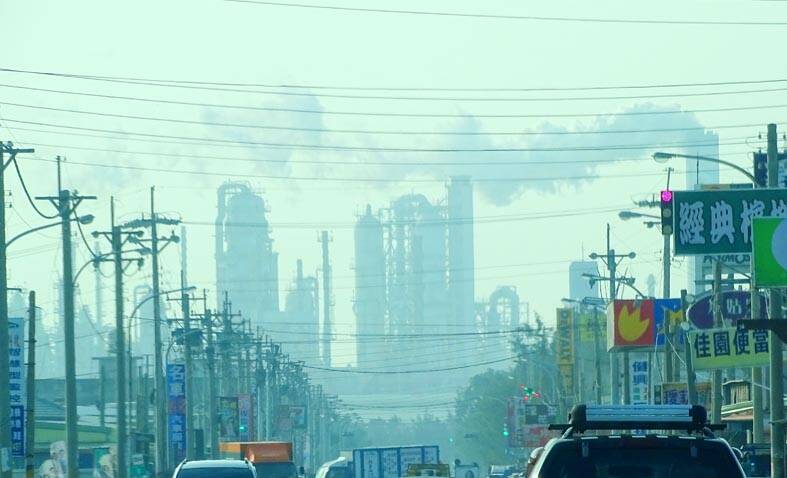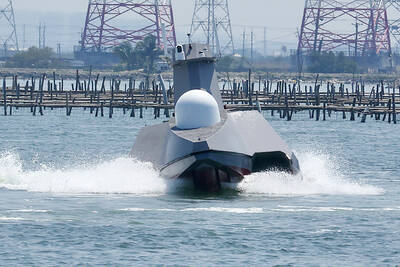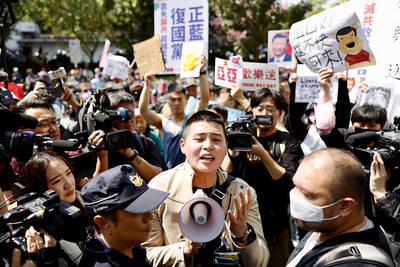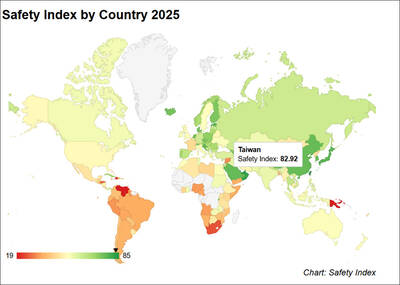Yunlin County had the nation’s highest annual average concentration of airborne particles measuring 2.5 micrometers (PM2.5) or less last year, data from the Ministry of Environment showed.
The county recorded an average PM2.5 concentration of 19.3 micrograms per cubic meter (mcg/m3), followed by nearby Chiayi County and Chiayi City, as well as outlying Kinmen, all at 18.8mcg/m3, the data showed.
Taiwan hopes to lower its annual average PM2.5 level to less than 13mcg/m3 and the annual average PM2.5 concentration in central and southern Taiwan to less than 15mcg/m3 by 2027, the ministry said.

Photo: Chan Shih-hung, Taipei Times
Department of Atmospheric Environment head Chang Shun-chin (張順欽) said that a higher PM2.5 level in central and southern Taiwan was mainly a result of less rain and low wind speeds there.
Those conditions led to particulate matter not being able to diffuse into the air, resulting in the local accumulation of pollutants, he said.
In terms of the annual average concentration of nitrogen dioxide, data showed that Taipei led the nation with 13.87 parts per billion (ppb), followed by Kaohsiung at 11.49ppb.
Areas such as New Taipei City, Taoyuan, Hsinchu City and Taichung also recorded relatively high levels.
Mobile sources of pollution and topography greatly contributed to the situation, Chang said.
For example, in Taipei, a high number of vehicles, coupled with its basin topography and poor dispersion, resulted in higher nitrogen dioxide concentrations.
Additionally, as nitrogen dioxide is a precursor to ozone, the overall ozone concentrations in the western part of Taiwan — where those cities are located — are also higher than those in the east, he said.
The data also showed the status of other major pollutants, such as PM10, an indicator of airborne particles measuring 10 micrometers or less. Yunlin County’s annual average was the highest (41.5mcg/m3), followed by Changhua County (40.8mcg/m3) and Chiayi County (40.2mcg/m3).
These values were below the annual average of 50mcg/m3 set by the ministry.

ENDEAVOR MANTA: The ship is programmed to automatically return to its designated home port and would self-destruct if seized by another party The Endeavor Manta, Taiwan’s first military-specification uncrewed surface vehicle (USV) tailor-made to operate in the Taiwan Strait in a bid to bolster the nation’s asymmetric combat capabilities made its first appearance at Kaohsiung’s Singda Harbor yesterday. Taking inspiration from Ukraine’s navy, which is using USVs to force Russia’s Black Sea fleet to take shelter within its own ports, CSBC Taiwan (台灣國際造船) established a research and development unit on USVs last year, CSBC chairman Huang Cheng-hung (黃正弘) said. With the exception of the satellite guidance system and the outboard motors — which were purchased from foreign companies that were not affiliated with Chinese-funded

PERMIT REVOKED: The influencer at a news conference said the National Immigration Agency was infringing on human rights and persecuting Chinese spouses Chinese influencer “Yaya in Taiwan” (亞亞在台灣) yesterday evening voluntarily left Taiwan, despite saying yesterday morning that she had “no intention” of leaving after her residence permit was revoked over her comments on Taiwan being “unified” with China by military force. The Ministry of the Interior yesterday had said that it could forcibly deport the influencer at midnight, but was considering taking a more flexible approach and beginning procedures this morning. The influencer, whose given name is Liu Zhenya (劉振亞), departed on a 8:45pm flight from Taipei International Airport (Songshan airport) to Fuzhou, China. Liu held a news conference at the airport at 7pm,

Taiwan was ranked the fourth-safest country in the world with a score of 82.9, trailing only Andorra, the United Arab Emirates and Qatar in Numbeo’s Safety Index by Country report. Taiwan’s score improved by 0.1 points compared with last year’s mid-year report, which had Taiwan fourth with a score of 82.8. However, both scores were lower than in last year’s first review, when Taiwan scored 83.3, and are a long way from when Taiwan was named the second-safest country in the world in 2021, scoring 84.8. Taiwan ranked higher than Singapore in ninth with a score of 77.4 and Japan in 10th with

GRIDLOCK: The National Fire Agency’s Special Search and Rescue team is on standby to travel to the countries to help out with the rescue effort A powerful earthquake rocked Myanmar and neighboring Thailand yesterday, killing at least three people in Bangkok and burying dozens when a high-rise building under construction collapsed. Footage shared on social media from Myanmar’s second-largest city showed widespread destruction, raising fears that many were trapped under the rubble or killed. The magnitude 7.7 earthquake, with an epicenter near Mandalay in Myanmar, struck at midday and was followed by a strong magnitude 6.4 aftershock. The extent of death, injury and destruction — especially in Myanmar, which is embroiled in a civil war and where information is tightly controlled at the best of times —